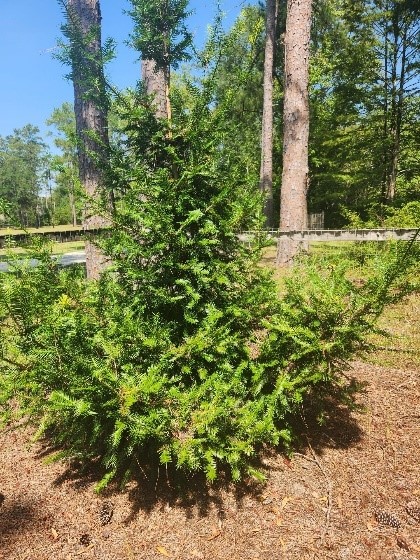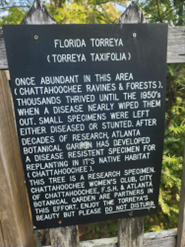In a tranquil forest area beside a pond, within the confines of the Florida State Hospital in Chattahoochee, stand two rare Florida Torreya trees, safely enclosed within a fenced perimeter and safeguarded by securely locked gates. As one approaches, a prominently posted sign on the fence conveys a message. “Once abundant in this area (Chattahoochee Ravines and Forests) thousands thrived until the 1950s when a disease nearly wiped them out. Small specimens were left either diseased or stunted. After decades of research, Atlanta Botanical Garden has developed a disease resistant specimen for replanting in its native habitat (Chattahoochee). This tree is a research specimen Chattahoochee, F.S.H and Atlanta Botanical Garden are partners in this effort. Enjoy the Torreya’s beauty but please DO NOT DISTURB.”
As we toured the site where the trees are planted, it was evident that members of the Chattahoochee Women’s Club worked diligently and patiently tending to these two rare trees, sparking my desire to further explore this rare beauty. In the Apalachicola drainage area of Gadsden and Liberty counties, along with southern Decatur County in Georgia, you can encounter Florida Torreya trees, which are also known as stinking cedar or gopher wood. Additionally, a group of these trees can be observed west of the Apalachicola River in Jackson County.

This evergreen tree has an upright, pyramid-like shape and features slender branches that gracefully arch downward and has unique needle-like glossy, dark green leaves. These trees can reach heights of up to 40 feet, with a canopy that spreads about 20 feet, and they are known for their notably slow growth rate.
The torreya tree, often regarded as one of the rarest conifers in North America, has witnessed a persistent decline spanning several decades, dating back to the late 1930s where the initial decline was noticeable, until the 1960s where no adult tree could be found. This decline can be attributed to various factors, including diseases, alterations in ecosystems, and other contributing factors. However, the primary cause has been identified as diseases caused by two fungal species of fusarium, specifically leading to leaf spots and stem cankers. Collaborative endeavors between various organizations, including government agencies, academic institutions, horticultural groups, and dedicated volunteers, continues to focus on conserving and safeguarding this endangered species. The future of the Florida Torreya hinges on understanding the disease-causing agent, Fusarium as well as the ongoing joint efforts of all stakeholders involved.
For more information visit: Florida Torreya – UF/IFAS https://extension. Extension: Solutions for Your Life (ufl.edu) ;
ENH-801/ST644: Torreya taxifolia: Florida torreya (ufl.edu)
- “Stink and Pretty”: The Pedagogy of Marigolds - May 22, 2025
- The Bold and the Beautiful in Your Landscape – Snapdragons - April 10, 2025
- Should You Be Concerned About the Grizzled Mantis? - February 27, 2025

